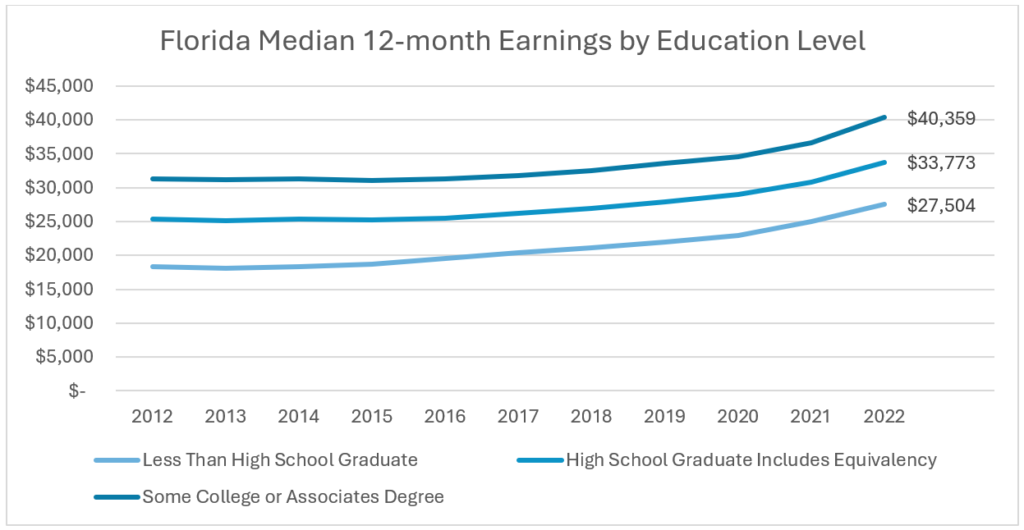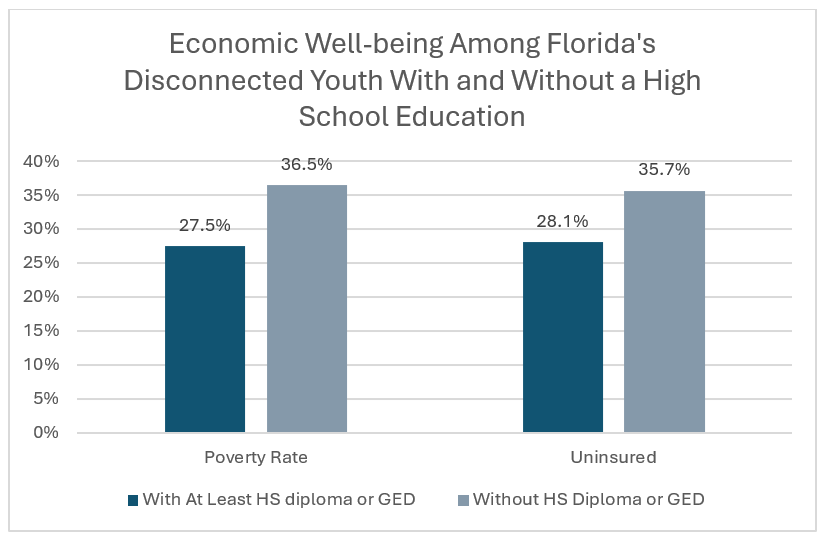Unlocking Florida’s Full Potential: Why Education Matters for Florida’s Disconnected Youth
 By: Keith Richard, PhD, VP of Research, Florida Chamber Foundation
By: Keith Richard, PhD, VP of Research, Florida Chamber Foundation
Florida’s future and economic success depends on engaging all Floridians, including an often overlooked population: disconnected youth. Ensuring these young Floridians have every opportunity to secure a path to prosperity is essential. However, barriers to obtaining a high school diploma or equivalent (e.g., a GED) often limit prosperity for many of these individuals.
Florida’s “disconnected youth” are individuals ages 16 to 24 who are not working and not in school. Approximately 11.3 percent of Florida’s youth are disconnected, a rate that is slightly higher than the national average of 10.9 percent.1 This means there are almost 267,000 disconnected youth residing in Florida who need to be re-engaged. Disconnected youth face unique challenges and, in Florida, are living in poverty at higher rates than connected youth (29.6 percent compared to 14.2 percent, respectively) and are more often uninsured (29.9 percent compared to 13.8 percent).1
Nearly One-Quarter of Florida’s Disconnected Youth (23.7 Percent, or Approximately 63,250) Also Do Not Have a High School Diploma or Equivalent1
The absence of a high school degree or equivalent has further implications as youth attempt to transition into the workforce. We know that, on average, more education is associated with higher earnings and increased likelihood of economic self-sufficiency. In fact, recent U.S. Census data show adults in Florida aged 25 or older with a high school diploma have a median income 23 percent higher than those without a high school diploma, and Floridians with some college (e.g., a postsecondary certificate, industry certification, or college coursework without any credential) or an associate’s degree have an income 47 percent higher on average than those without a high school diploma (see figure below).

Source: Table S1501, 2022 American Community Survey (ACS) 5-year Estimates, U.S. Census Bureau.
These differences vary based on the region of the state, the type of employment, and the postsecondary credential earned, but the story is clear—disconnected youth who we seek to reintegrate into the workforce will miss out on substantial earning potential without a high school diploma or GED.
Further, within the disconnected youth population in Florida, we see a clear disadvantage among those without a high school diploma or GED, as they have higher rates of poverty and being uninsured compared to disconnected youth with at least a high school diploma or GED.
 Source: 2022 American Community Survey (ACS) 1-Year Public Use Microdata Survey (PUMS), U.S. Census Bureau.
Source: 2022 American Community Survey (ACS) 1-Year Public Use Microdata Survey (PUMS), U.S. Census Bureau.
What Options Exist?
So, what options exist for Florida’s disconnected youth that we seek to reengage in Florida’s economy and what are the implications of not having a high school diploma? Two primary options are often discussed for these individuals without a high school diploma:
- Join the already 136,000 adult learners enrolled in a Florida public adult education program or GED preparation (information to facilitate enrolling can be found at Get There FL). This may also include enrollment into one of the 338 Integrated Education and Training (IET) programs that simultaneously prepare adult students with coursework that will articulate into specific Career and Technical Education (CTE) programs, to shorten their time to a postsecondary degree or certificate.
- For those who do not seek to earn their GED, it is sometimes recommended that these individuals pursue industry-recognized credentials, also referred to as industry certifications.
It is understandable that not all disconnected youth have the time or resources (e.g., limited transportation and free time – 16 percent of disconnected youth women are mothers compared to less than 5 percent connected youth women2) to attend face-to-face training via Adult Basic Education or Adult High School. Further, it is true that industry certifications are the standard to signal to employers essential skillsets to perform particular jobs. However, it is not simple and straightforward to bypass altogether obtaining a GED through means of an industry certification.
First, many industry certifications include specific training requirements that can typically only be obtained through a specific high school CTE program or postsecondary program of study3, and participation in a Florida postsecondary program inherently requires a high school diploma or GED.
Second, while there are some industry certifications that can be earned uncoupled from traditional classroom instruction, these can still require a high school diploma or equivalent as a necessary precondition for obtaining the industry certification.2 For example, the industry certifications for Certified Phlebotomy Technician, ECG Technician, Certified Pharmacy Technician, Certified Clinical Medical Assistant, and Firefighter I and II all require a high school diploma or equivalent, even for individuals who have on-the-job experience in lieu of related coursework to meet the eligibility requirements.
Third, it is worth noting that some entrepreneurial youth and self-learners who wish to bypass formal classroom instruction can indeed test for and earn a range of industry certifications in the fields of information technology and cybersecurity.2 However, their career trajectory may still be stifled if they seek advancement in their field and they do not have the high school diploma or equivalent necessary to enroll in formal postsecondary education. For example, analysis of online job ads for Information Security Analysts in Florida over the past year shows that 70 percent of job postings requested incumbents have a bachelor’s degree.4
Florida’s Opportunity to Support Disconnected Youth
In addressing the challenges faced by Florida’s disconnected youth, it is evident that economic prosperity and well-being may hinge significantly on access to education. With nearly one-quarter of Florida’s disconnected youth lacking a high school diploma or equivalent, the path to prosperity remains further obstructed for many. To bridge this gap, access to high-quality Adult Education may provide the most secure pathway for individuals to increase their earnings and pursue further postsecondary education or industry certifications. As Florida seeks to reengage its disconnected youth, investing in educational opportunities and additional supports for these disconnected youth is not only a moral imperative, but a strategic opportunity to strengthen Florida’s long-term prosperity and increase the number of skilled workers added to our economy.
For questions about this writeup and/or to learn about the Florida Chamber Foundation’s efforts to secure a path to economic prosperity for Florida’s disconnected youth, feel free to contact me directly at krichard@flchamber.com.
[1] 2022 American Community Survey (ACS) 1-Year Public Use Microdata Survey (PUMS), U.S. Census Bureau.
[2] 2022 American Community Survey (ACS) 1-Year Public Use Microdata Survey (PUMS), U.S. Census Bureau. Note, “mothers” are an identifiable, predefined subset population in the PUMS individual-level dataset, whereas “fathers” must be imputed by linking individual-level data to other datasets. Therefore, fathers are not included in the current analyses.
[3] CAPE Industry Certification Funding List (fldoe.org)
[4] Education Meets Opportunity Platform, www.floridaemop.com.